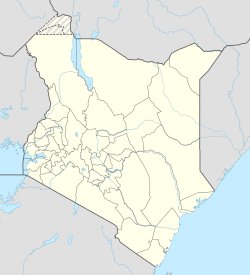
Back Найроби ADY Nairobi Afrikaans Nairobi ALS ናይሮቢ Amharic Nairobi AN نيروبي Arabic نايروبي ARY نايروبى ARZ নাইৰোবি Assamese Nairobi AST
Nairobi | |
|---|---|
 Clockwise from top: central business district; a giraffe walking in Nairobi National Park; Parliament of Kenya; Nairobi City Hall; and the Kenyatta International Convention Centre | |
| Nickname: "The Green City in the Sun" | |
| Coordinates: 01°17′11″S 36°49′02″E / 1.28639°S 36.81722°E | |
| Country | |
| County | Nairobi City |
| Founded | 1899 |
| Sub-counties | |
| Government | |
| • Body | Nairobi City County |
| • Legislature | County Assembly |
| • Governor | Johnson Sakaja |
| Area | |
| 696.1 km2 (268.8 sq mi) | |
| Elevation | 1,795 m (5,889 ft) |
| Population (2019)[3] | |
| 4,721,000 | |
• Estimate (2024)[4] | 4,828,000 |
| • Density | 6,800/km2 (18,000/sq mi) |
| • Urban | 5,541,000 |
| Demonym | Nairobian |
| GDP (PPP) | |
| • Total | City |
| • Per Capita | |
| GDP (NOMINAL) | |
| • Total | City |
| • Per Capita | |
| Time zone | UTC+03:00 (EAT) |
| Area code | 020 |
| HDI (2024) | 0.703[6] high |
| Website | nairobi |
Nairobi (/naɪˈroʊbi/ ny-ROH-bee) is the capital and largest city of Kenya. The name is derived from the Maasai phrase Enkare Nairobi, which translates to 'place of cool waters', a reference to the Nairobi River which flows through the city. The city proper had a population of 4,397,073 in the 2019 census.[7][8]
Nairobi is home of the Kenyan Parliament Buildings and hosts thousands of Kenyan businesses and key international companies and organisations, including the United Nations Environment Programme (UN Environment) and the United Nations Office at Nairobi (UNON). Nairobi is an established hub for business and culture. The Nairobi Securities Exchange (NSE) is one of the largest stock exchanges in Africa and the second-oldest exchange on the continent. It is Africa's fourth-largest stock exchange in terms of trading volume, capable of making 10 million trades a day. It also contains the Nairobi National Park. Nairobi joined the UNESCO Global Network of Learning Cities in 2010.
Nairobi was founded in 1899 by colonial authorities in British East Africa, as a rail depot on the Uganda - Kenya Railway. It was favoured by the authorities as an ideal resting place due to its high elevation, temperate climate, and adequate water supply.[9] The town quickly grew to replace Mombasa as the capital of Kenya in 1907.[10]
After independence in 1963, Nairobi became the capital of the Republic of Kenya.[11] During Kenya's early period, the city became a centre for the coffee, tea and sisal industries.[12][13] The successive black governments since independence have built and turned Nairobi into a modern metropolitan city with a diverse population and a growing economy.[14] Nairobi continues to thrive as the capital of Kenya.The city lies in the south central part of Kenya, at an elevation of 1,795 metres (5,889 ft).
- ^ "Nairobi County". Infotrak. Archived from the original on 8 November 2022. Retrieved 8 November 2022.
- ^ "Nairobi Population 2022". World Population Review. Archived from the original on 29 May 2023. Retrieved 8 November 2022.
- ^ "2019 Kenya Population and Housing Census Volume I: Population by County and Sub-County". knbs.or.ke. Archived from the original on 13 November 2019. Retrieved 7 November 2019.
- ^ "2019 KPHC – Analytical Report on Population Projections Vol XVI". Kenya National Bureau of Statistics. September 2022. p. 38. Archived from the original on 4 December 2022. Retrieved 29 February 2024.
- ^ "GCP". Retrieved 31 August 2021.
- ^ Global Data Lab. "Human Development Indices: Sub-national HDI". globaldatalab.org. Retrieved 22 August 2021.
- ^ "2019 Kenya Population and Housing Census Volume I: Population by County and Sub-County". Kenya Central Bureau of Statistics. Archived from the original on 13 November 2019. Retrieved 7 November 2019.
- ^ Omwenga, Mairura (19 September 2010). "Nairobi Emerging Metropolitan Region Development Planning and Management Opportunities and Challenges" (PDF). ISOCARP CONGRESS. 46th ISOCARP Congress. Nairobi. pp. 1–5. Archived (PDF) from the original on 17 November 2022. Retrieved 17 November 2022.
- ^ Roger S. Greenway, Timothy M. Monsma, Cities: missions' new frontier, (Baker Book House: 1989), p.163.
- ^ mombasa.go.ke (28 July 2018). "History of Mombasa". Mombasa County. Archived from the original on 26 January 2021. Retrieved 14 June 2019.
- ^ britannica.com. "Nairobi History". www.britannica.com/. Archived from the original on 11 December 2019. Retrieved 18 February 2020.
- ^ "Production". East Africa Sisal. Archived from the original on 22 July 2020. Retrieved 24 May 2020.
- ^ Rashid, Mahbub (16 June 2016). The Geometry of Urban Layouts: A Global Comparative Study. Springer. ISBN 978-3-319-30750-3.
- ^ "Nairobi, Kenya | History Timeline". History Timelines. Retrieved 19 January 2025.
Cite error: There are <ref group=lower-alpha> tags or {{efn}} templates on this page, but the references will not show without a {{reflist|group=lower-alpha}} template or {{notelist}} template (see the help page).


